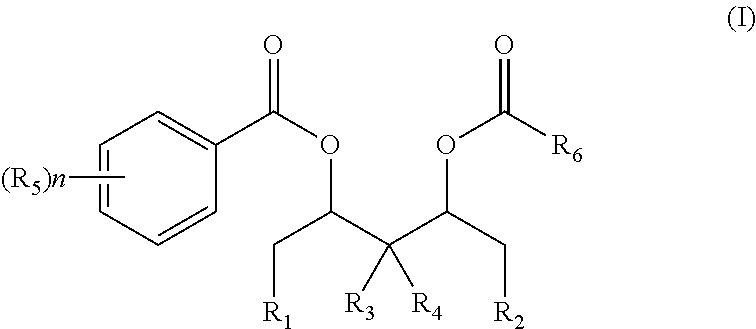Catalyst component for olefin polymerization, catalyst, and use thereof
a technology of olefin polymerization and catalyst, which is applied in the field of catalyst components, can solve the problems of unsatisfactory hydrogen response, stereoselectivity of the catalyst, and the achieve the effects of improving the hydrogen response and polymerization activity of the catalyst, high melt index, and high isotacticity
- Summary
- Abstract
- Description
- Claims
- Application Information
AI Technical Summary
Benefits of technology
Problems solved by technology
Method used
Image
Examples
examples 1 to 5
Preparation of a Catalyst Component
[0070]In a reactor in which air is adequately replaced with high purity nitrogen, 6.0 g of magnesium chloride, 119 ml of toluene, 5 ml of epoxy chloropropane, and 15.6 ml of tributyl phosphate (TBP) are successively added. The temperature is raised to 50° C. under stirring and kept constant for 2.5 hours until the solid is completely dissolved. Next, 1.7 g of phthalic anhydride is added, and the temperature is kept for 1 hour. The temperature is then lowered to below −25° C. followed by addition of 70 ml of TiCl4 within one hour. After that, the temperature is slowly raised to 80° C., during which a solid is gradually precipitated out. Subsequently, 4.6 mmol of the diol diester compound (I) as shown in Table 1 is added, and the temperature is kept constant for one hour. After filtration, 80 ml of toluene is added into the reactor and washing is performed twice to obtain a solid precipitate.
[0071]Afterwards, 60 ml of toluene and 40 ml of TiCl4 are a...
examples 6 to 9
[0073]Under protection of nitrogen, 4.8 g of anhydrous magnesium chloride, 19.5 g of isooctanol, and 19.5 g of decane as a solvent are added into a 500 ml reactor arranged with a stirrer. The temperature is raised to 130° C. followed by reaction of 1.5 hours until magnesium chloride is completely dissolved. 1.1 g of phthalic anhydride is added into the reactor and the temperature is kept constant at 130° C., followed by reaction of one hour to obtain an alcoholate, which is then cooled to room temperature.
[0074]Under protection of nitrogen, the above alcoholate is dropwise added into 120 ml of a TiCl4 solution pre-cooled to −22° C. The temperature is slowly raised to 100° C., followed by addition of 10 mmol of diol diester compounds as shown in Formula (I) respectively. The temperature is raised to 110° C. and kept constant for 2 hours, which precedes hot filtration. Afterwards, 120 ml of TiCl4 is added and the temperature is raised to 110° C. and kept constant for 1 hour, followed ...
PUM
| Property | Measurement | Unit |
|---|---|---|
| temperature | aaaaa | aaaaa |
| temperature | aaaaa | aaaaa |
| temperature | aaaaa | aaaaa |
Abstract
Description
Claims
Application Information
 Login to View More
Login to View More - R&D
- Intellectual Property
- Life Sciences
- Materials
- Tech Scout
- Unparalleled Data Quality
- Higher Quality Content
- 60% Fewer Hallucinations
Browse by: Latest US Patents, China's latest patents, Technical Efficacy Thesaurus, Application Domain, Technology Topic, Popular Technical Reports.
© 2025 PatSnap. All rights reserved.Legal|Privacy policy|Modern Slavery Act Transparency Statement|Sitemap|About US| Contact US: help@patsnap.com


